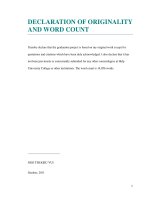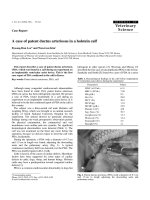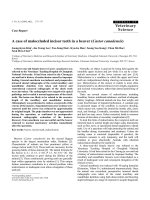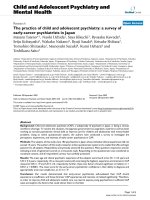Factors influencing organizational climate and job performance: A case of VHSE agricultural teachers in Kerala
Bạn đang xem bản rút gọn của tài liệu. Xem và tải ngay bản đầy đủ của tài liệu tại đây (236.39 KB, 7 trang )
Int.J.Curr.Microbiol.App.Sci (2020) 9(8): 1725-1731
International Journal of Current Microbiology and Applied Sciences
ISSN: 2319-7706 Volume 9 Number 8 (2020)
Journal homepage:
Original Research Article
/>
Factors Influencing Organizational Climate and Job Performance: A Case
of VHSE Agricultural Teachers in Kerala
Chhanda Charana Mahananda*, G. S. Sreedaya and Deinichwa Dkhar
Department of Agricultural Extension, College of Agriculture, Vellayani, Kerala Agricultural
University, Kerala, India
*Corresponding author
ABSTRACT
Keywords
Job performance,
organizational
climate, VHSE,
Agricultural
teachers, Factor
analysis, Kerala,
knowledge
management,
organizational
culture,
organizational
communication
Article Info
Accepted:
18 July 2020
Available Online:
10 August 2020
Well-trained and highly skilled teachers play a vital role in the performance
of the students and the schools as teachers are considered the soul of the
school and play a key part in society's upliftment and nation's growth. To
intensify the effectiveness of the educational organizations it is needed to
increase the efficiency of the teachers by exploring the factors that have the
potency to boost the job performance of the teachers since teachers are the
key personals of an educational organization. Hence, the study was
conducted among 120 VHSE agricultural teachers selected from the three
zones of Kerala namely; Northern zone, Central zone and Southern zone
with the objectives to explore the factors that are affecting the
organizational climate and the job performance of the VHSE Agricultural
teachers and to know relationship among them. The study revealed three
factors each influencing the organizational climate and job performance of
the teachers, and also the relationship between them were found to be
positive and significantly correlated.
Introduction
In Kerala, vocational education in agriculture
focuses specifically on improving students'
skills, abilities, knowledge and personality to
make them employable and self-employed in
the agricultural and related sectors. It can be
accomplished by enhancing the efficiency of
the VHSE Agricultural teachers and by
raising consciousness among the peoples in
the state about VHSE. Since, VHSE is a form
of organization therefore studying the
organization climate is of great importance.
An organization comprises of a collection of
people working together within a system to
achieve a common goal and its success relies
largely on the individuals engaged in it.
Organizational
development
is
a
1725
Int.J.Curr.Microbiol.App.Sci (2020) 9(8): 1725-1731
determination, planned and managed from the
top to improve the efficiency and safety of the
organization
through
systematic
organizational process measures (Backhard,
1969).
Organizational climate may be defined as
mutually agreed perceptions of the employees
on their internal environmental description of
an organization’s practices and procedures
(Schneider, 1975). It is also an internal
component that influences and distinguishes
the behaviour of individuals from others
organization. The organizational climate is
the internal work environment in which all the
members, i.e. teachers, administrators and
other staff, work within the organization
(Selamat et al., 2013). The organizational
climate is the school's identity, wherein the
sense of confidence and involvement of the
teachers were reflected in their performance.
The organizational climate has a considerable
impact on the teachers ' job performance.
According to Getzels (1958), the function of
both role and character is the performance of
an individual in an organization. Job
performance is an expected product of a
combination of factors such as personality,
determination, knowledge, skill, quality of
work, motivation, organizational climate and
willingness to accomplish work. Teaching is
multifaceted and need varieties of human
traits and abilities such as teachers’ mental
abilities and skills, his knowledge of the
subject matter, personality, beliefs, attitude,
interest and relationship with students,
teachers and all members of the school.
Hence, for increasing the efficiency of the
VHSE School, it is needed to uplift the job
performance of the teachers through
establishing an enlightening organizational
climate in the school.
From the circumstantial explained above, the
present study tries to understand the VHSE
organizational system with the objectives to
find out the factors influencing the
organizational climate, to know the factors
affecting the job performance of the teachers
and to study the relationship between the
profile data of teachers, organizational
climate and job performance.
Materials and Methods
The study was conducted via multistage
random sampling. A total of 120 VHSE
agricultural teachers were selected from the
three zones of Kerala namely, Northern zone,
Central zone and Southern zone and three
districts each were selected from the three
zones, i.e., Kasaragod, Kozhikode and
Malappuram district from the Northern zone;
Palakkad, Thrissur and Ernakulam district
from
the
Central
zone
and
Thiruvananthapuram, Kollam and Kottayam
district were selected from the Southern zone.
Ex-post-facto research design was followed
and a structured interview schedule having a 7
statements with five-point Likert scale (1
strongly disagree to 5 strongly agree) were
used
for
organizational
climate(scale
developed by Kolb et al., 1974) and 7
statement for Job Performance (scale created
by Sundaraswamy, 1987) with three-point
Likert scale (3 More efficient, 2 Efficient and
1 Less Efficient) were used for the data
collection. Likewise, age, gender, educational
level and job experience (in years) were
collected as the profile data of the teachers.
Statistical tools such as Factor Analysis and
Correlation were applied using Statistical
Package for the Social Sciences (SPSS)
software. Factor analysis is a technique of
interdependence whose main objective is to
identify the underlying structure in the
assessment among the variables (Hair et al.,
2014). It also delivers the techniques to
investigate the structure of interrelationships
(correlations) among a large number of
1726
Int.J.Curr.Microbiol.App.Sci (2020) 9(8): 1725-1731
variables (test scores, test items, questionnaire
responses) by identifying sets of extremely
interrelated variables, known as factors.
The general purpose of factor analysis
techniques is to find a way to summarize the
information contain in a number of original
variables into a smaller set of new, composite
dimensions or factors with minimal
information loss i.e. to search for and define
the foundational structures or dimensions
assumed to underlie the original variables.
Principle Axis Factoring Extraction method
with Varimax rotation method were employed
to find out the factors associate with the seven
statements that represent the organizational
climate and three factors were extracted based
on the cumulative variance (about 60%) and
the eigenvalues (Table 1). Table 2 represent
the rotated factor matrix, that show the
selected factor loading values obtained
against each statement and each factor
extracted. The factor loading values were
selected for each statement based on the
highest scores across the row.
Results and Discussion
The profile data of the VHSE Agricultural
teachers found that majority of the teachers
(95%) belonged to the middle age (35-55
years) group and 72per cent of them were
females. Furthermore, it was found that 59 per
cent of the teachers were having a master's
educational qualification and majority of the
teachers (76%) having an average (8-14
years) job experience. The result also revealed
from the scored interview schedule on
organizational climate that 60per cent of the
teachers experience a good (27 – 35 score)
organizational climate and rest 40 per cent
experience an average (17 – 26 score)
organizational climate. It was also observed
that half of the teachers (50 %) had a high (17
– 21 score) level of job performance whereas
remaining 5 per cent and 45 per cent had a
low (7 – 11 score) and medium (12 – 16
score) level of performance respectively.
Table 3 represents the grouping and naming
of the factors that are associated with the
organizational climate. The groupings of the
statements under the factors were done by
selecting the statements with the selected
factor loading value. Naming of the factors
was given after observing the group of
statements that comes under the factor. Here
three factors were extracted. The first one is
Organizational Culture (F1) and it represented
through 4 statements that are 1, 5, 6 and 7
with factor loading value. 662, 738, 459 and.
826 respectively (Table 3). The second factor
is Autonomy of Teachers (F2) and it
represented through 2 statements that are 2
and 3 with factor loading value. 677 and. 662
respectively (Table 3) and the third factor is
the Organizational Communication (F3) that
characterized by only statement no.3 with the
factor loading value. 711.
Table.1 Total Variance Explained in Organizational climate
Total Variance Explained (in Organizational climate)
Factor
Extraction Sums of Squared Loadings
Rotation Sums of Squared Loadings
Eigen value
% of
Cumulative Eigen value
% of
Cumulative
Variance
%
Variance
%
F1
2.782
39.748
39.748
1.943
27.756
27.756
F2
.783
11.181
50.929
1.365
19.500
47.255
F3
.590
8.429
59.358
.847
12.102
59.358
Extraction Method: Principal Axis Factoring.
Varimax Rotated Factors
1727
Int.J.Curr.Microbiol.App.Sci (2020) 9(8): 1725-1731
Table.2 Component matrix, varimax rotated factors of organizational climate
Rotated Factor Matrix
Organizational climate
Statements
1
There are not many rules, regulations, procedures and
activities in the school under which I must follow rather than
function as I see fit.
2
I can make decisions and solve problems without checking
with supervisors in each step of the work.
3
The school setting goals and communicating these goals to its
members for quality and outstanding production
4
As need for leadership arise, members feel free to take
leadership roles and also rewarded for good work.
5
Things are well organized and goals are clearly defined than
being disorderly, confused or messy.
6
Friendliness is a valued norm in the school that you can trust
one another and other support to one another.
7
The school gives value to good works of each member and
doesn’t ignore or punish if anything is wrong.
Extraction Method: Principal Axis Factoring.
Rotation Method: Varimax with Kaiser Normalization.
F1
.662
Factor
F2
F3
.677
.71
1
.66
2
.738
.459
.826
Table.3 Grouping and naming the factors of organizational climate
No.
F1. ORGANIZATIONAL CULTURE
1
There are not many rules, regulations, procedures and activities in the school
under which I must follow rather than function as I see fit.
Things are well organized and goals are clearly defined than being disorderly,
confused or messy.
Friendliness is a valued norm in the school that you can trust one another and
other support to one another.
The school gives value to good works of each member and doesn’t ignore or
punish if anything is wrong.
F2. AUTONOMY OF TEACHERS
I can make decisions and solve problems without checking with supervisors
in each step of the work.
As need for leadership arise, members feel free to take leadership roles and
also rewarded for good work.
F3. ORGANIZATIONAL COMMUNICATION
The school setting goals and communicating these goals to its members for
quality and outstanding production
5
6
7
2
4
3
1728
Factor
loading
.662
.738
.459
.826
.677
.662
.711
Int.J.Curr.Microbiol.App.Sci (2020) 9(8): 1725-1731
Table.4 Total Variance explained in job performance
Total Variance Explained (in job performance)
Factor
Extraction Sums of Squared Loadings
Rotation Sums of Squared Loadings
Eigen value
% of
Cumulative Eigen value
% of
Cumulative
Variance
%
Variance
%
F1
2.461
35.160
35.160
1.516
21.661
21.661
F2
1.139
16.269
51.429
1.482
21.172
42.833
F3
.755
10.785
62.214
1.357
19.381
62.214
Extraction Method: Principal Axis Factoring.
Rotation Method: Varimax with Kaiser Normalization.
Table.5 Component matrix, varimax rotated factors of job performance
Rotated Factor Matrix
Job performance
Statement
1
I use information to schedule suitable curricula, execute teaching policies, and use
resources to encourage learning for all students.
2
By addressing individual learning differences and using efficient teaching strategies, I
encourage student learning.
3
I analyze assessment data to measure student progress and guide immediate and longrange instruction.
4
I provide a well-managed, safe student-centered environment that is academically
challenging.
5
I communicate effectively with students, staff, parents, and the community.
6
I maintain a professional personality, engage in activities for professional
development, show curriculum knowledge and contribute to the profession.
7
My job of teaching results in acceptable, measurable and student progress.
Extraction Method: Principal Axis Factoring.
Rotation Method: Varimax with Kaiser Normalization.
F1
Factor
F2
F3
.640
.485
.934
.491
.823
.820
.737
Table.6 Naming the factors of job performance
No.
F1. TEACHING SKILL
2
By addressing individual learning differences and using efficient teaching strategies, I encourage student
learning.
I analyze assessment data to measure student progress and guide immediate and long-range instruction.
I provide a well-managed, safe student-centered environment that is academically challenging.
F2. COMMUNICATION SKILL
I communicate effectively with students, staff, parents, and the community.
My job of teaching results in acceptable, measurable and student progress.
F3. KNOWLEDGE MANAGEMENT
I use information to schedule suitable curricula, execute teaching policies, and use resources to encourage
learning for all students.
I maintain a professional personality, engage in activities for professional development, show curriculum
knowledge and contribute to the profession.
3
4
5
7
1
6
1729
Factor
loading
.485
.934
.491
.823
.737
.640
.820
Int.J.Curr.Microbiol.App.Sci (2020) 9(8): 1725-1731
Table.7 Correlation between profile characteristics of teachers,
organizational climate and job performance
Sl. No.
1
2
3
4
6
Items
Coefficient of Correlation „r‟ Values
Age
-0.210 *
Gender
0.101 NS
Education
-0.052 NS
Job experience
0.043 NS
Organizational climate
0.206 *
“*” significant at 5% level, “NS” Non-significant
The same method i.e. Principle Axis
Factoring Extraction method with Varimax
rotation was employed to find out the factors
associate with the seven statements that
represent the job performance of the teachers
and 3 factors were extracted based on the
cumulative variance (about 63%) and the
eigenvalues (Table 4). Table 5 represent the
rotated factor matrix, that show the selected
factor loading values obtained against each
statement and each factor extracted. The
factor loading values were selected for each
statement based on the highest scores across
the row.
Table 6 represents the grouping and naming
of the factors that are associated with the job
performance. The grouping of the statements
under the factors was done by selecting the
statements with the selected factor loading
value. Naming of the factors was given after
observing the group of statements that comes
under the factor. Here 3 factors were
extracted. One is Teaching Skill (F1) and it
represented through 3 statements that are 2, 3
and 4 with factor loading value, 485 934 and
491 respectively (Table 6). The second factor
is Communication Skill (F2) and it
represented through 2 statements that are 5
and 7 with factor loading value, 823 and. 737
respectively (Table 6). And the third factor is
the Knowledge Management (F3) that
characterized by two statements i.e. 1 and 6
with the factor loading value, 640 and 820
respectively.
Furthermore, the correlation analysis (Table
7) showed that there was a positive and
significant correlation between organizational
climate and the job performance of the
teachers. It was also found that there was a
negative correlation between age and job
performance of teachers.
It can be concluded from the above analysis
that the three factors imparting organizational
climate
were
Organizational
Culture,
Autonomy of Teachers and Organizational
Communication and three factors impacting
the job performance were Teaching Skill,
Communication Skill and the Knowledge
Management of teachers. It was also seen that
the organizational climate showed a positively
correlation with the job performance of the
teacher.
All together the study pointed that, a teacher
with good teaching skill, communication skill
and knowledge management skill can enhance
their job performance in a school having good
organizational culture, autonomy toward
teachers and a good organizational
communication. The performance of the
school increases when the performance of the
teacher is higher. So for increasing the
performance of the school the organizational
climate of the school needs to be strengthen
with preferred organizational culture,
providing autonomy to teachers and establish
a good organizational communication system
by adopting favorable organizational policies,
1730
Int.J.Curr.Microbiol.App.Sci (2020) 9(8): 1725-1731
rules & regulations and also increase the
teaching skill, communication skill and
knowledge management skill of the teachers
by providing advanced training and capacity
building programmes for upgradation of
knowledge and information.
References
Backhard,
R.
1969.
Organizational
Development: Strategies and Models.
Reading, Mass, Addison Wesley
Publishing Co., Boston, 119p.
Getzels, J. M. 1958. Administration as a
social process. In. Halpin, A. W. (Ed.)
Administrative theory in Education.
Midwest
Administrationcentre,
Chicago, 152 p.
Hair, J. F., Black, W. C., Babin, B. J. and
Anderson, R. E. 2014. Multivariate
Data Analysis (7th Ed.), Pearson
Education Ltd., London, pp. 106-109.
Kolb, D. A., Rubin, I. M. and Mclntyre, J. M.
1974. Organizational Psychological: an
experiential approach (2nd Ed.).
Prentice Hall Inc., New Jersey, 422p.
Scheinder, B. and Snyder, R. A. 1975. Some
relationship between job satisfaction
and organizational commitment. J.
Appl. Psychol. 60: 318-328.
Selamat, N., Taufig, N. Z. and Kamalu, N.
2013. The impact of organizational
climate on teachers’ job performance.
Educ. Res. e-Journal. 2(1):71-82.
Sundaraswamy, B. 1987. A study on need
achievement and job performance of
Assistant Agricultural Officers in
Karnataka State. Ph.D. (Ag) thesis,
Tamil Nadu Agricultural University,
Coimbatore, 321p.
How to cite this article:
Chhanda Charana Mahananda, G. S. Sreedaya and Deinichwa Dkhar. 2020. Factors Influencing
Organizational Climate and Job Performance: A Case of VHSE Agricultural Teachers in
Kerala. Int.J.Curr.Microbiol.App.Sci. 9(08): 1725-1731.
doi: />
1731









